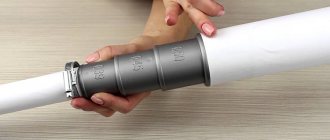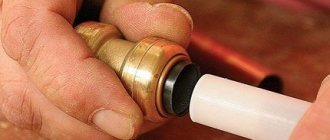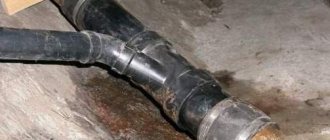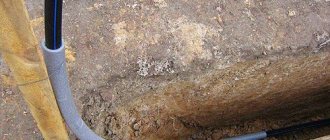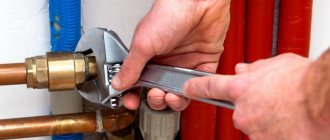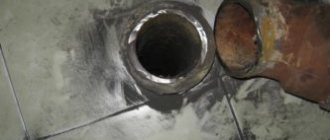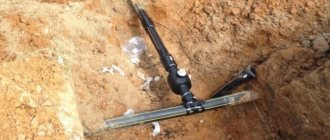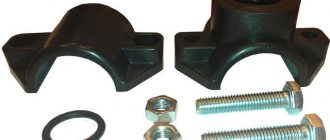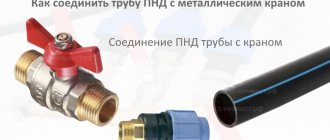When welding metal pipes, one of the main problems is not only the availability of tools, time and effort, but also the skills, that is, experience that will help you weld one piece of pipe to another. However, the shapes in this case can be very complex and simply drawing with a pencil and cutting off will not work. Or rather, it will work out, but such forms are not at all guaranteed to allow you to weld pipes together normally. Actually, we suggest that you use a little trick that will greatly facilitate the process of marking the pipe for connecting it together.
In order to mark the pipe, we will need to use electrodes, the same ones that every welder has. After all, we had to use something to weld these metal pipes. So, let's see how to do it. We take electrodes.
We put it on the pipe that we are going to weld. Moreover, it can be even smaller in diameter than the one we are going to weld to, but definitely not larger! Although this is logical.
We place the pipe with electrodes at the planned welding site and extend the electrodes so that they touch the entire surface of the pipe.
Now the pipe must be carefully pulled out from the electrodes, so as not to disturb their positioning, and make markings using a marker. You can also use a marker to mark on the pipe where we will weld.
Next you need to use a machining tool. Let's check what we got.
Well, let’s weld everything in place.
The gap turned out neat without gaps or targets. Just what we needed!
Another option for cutting pipes, when it is necessary to weld pipe to pipe at an angle, is cavity to cavity. More on this in another article.
Source: xn——7kcglddctzgerobebivoffrddel5x.xn--p1ai
How to cut a corrugated pipe with a grinder
The most popular way of cutting at home is to use a grinder. to cut evenly with a grinder? The main problem of doing the work is the correct markup.
To apply markings you can use:
- tape measure, square, marker (pencil), building level. The simplest tools allow you to fairly accurately mark the angle of the cut, but during the work, the angle grinder may deviate from the specified cutting line (the equipment does not rest on stands, but is suspended, that is, in the hands of the master), which will lead to an error. For this reason, this method is used extremely rarely;
Marking for cutting using a square
Pipe cutting methods
To cut a profile pipe, including at a certain angle, you can use the following tool:
- angle grinder - grinder (picture above). This method is most often used for domestic purposes, as it is characterized by the simplicity and availability of equipment;
- hacksaw for metal. Using a hacksaw is not difficult, but the process of doing the work is quite labor-intensive;
Using a hacksaw for cutting corrugated pipes
- special machine for cutting pipes. The equipment is most often used by professionals due to its high cost. Currently, specialists use two types of machines:
- equipment with mechanical cutting, which is performed with a cutting wheel or a special file;
- laser equipment. Laser cutting is more accurate compared to mechanical analogues.
Using a special laser cutting machine
When choosing any method, it is important to pay special attention to safety precautions. When cutting corrugated pipes, metal shavings are formed, which can damage the hands and eyes of the master, so it is important to wear gloves and safety glasses before performing the work.
How to cut a cast iron pipe
Cast iron as a material has its own specifics and differs from iron alloys in a number of physical and mechanical features. Despite its highest strength, cast iron is a very brittle material.
How to cut a round pipe at 45 degrees to connect at 90.
The metal pipe exactly like the iron pipe. Before work, you should place wooden logs for support. Using an angle grinder with a cutting disc, make a shallow cut around the entire circumference. Next, the chisel inserted into the cut must be struck with great force. The product will split evenly along the saw line.
If the angle grinder is out of reach, you will have to make a ring cut with a hacksaw.
How to cut a profile pipe
Profile pipes are widely used in everyday life. The material is used for the construction of greenhouse complexes, benches, tables and other garden furniture, canopies, swings and other small architectural forms. It is for this reason that it is important to know how to correctly cut a profile pipe at an angle of 45 degrees, 90°, and so on, as well as along.
Features of cutting pipes lengthwise
Using a grinder, you can make not only a transverse, but also a longitudinal cut of a profile pipe. How to properly cut a multi-profile pipe lengthwise? The work is performed in the following order:
- as with cross cuts, the work begins with marking. It is important to determine as many reference points as possible on the side surface of the pipe in order to obtain the most even line possible;
Applying markings for longitudinal cuts
- to improve visibility and eliminate the possibility of an uneven cut, it is recommended to highlight the resulting line (with paint or masking tape);
- the pipe is fixed, for example, with clamps. If possible, you can also fix the grinder, as an option - using a special stand;
- a cut is gradually made along a given mowing line.
Cutting a pipe lengthwise with a grinder fixed on a stand
Using a similar technology, thick-walled profile pipes are cut. Before performing work, the pipe must be fixed, which eliminates the possibility of the workpiece breaking under its own weight.
Miter box for cutting pipes
It is very convenient to cut a profile pipe using a special template, which is an analogue of a construction miter box for cutting building materials at different angles.
To do this, using the above or another method, a metal template is made from a piece of profile pipe cut along the length; it can be designed to obtain a right angle or an angle of 45 degrees.
To cut a metal profile, a template is applied to it and a line is drawn with a scriber, along which a cut is then made. In other cases, the template is held and a grinder is used to draw the fishing line along the surface of the workpiece, trying to avoid strong pressing of the side surface of the disk against the attached metal template. Then the template is removed and cutting continues along a clearly visible depression on the edges of the workpiece.
READ How to cut plastic panels
Using a template, you can get a very even cut line if you do not hold it manually, but secure it to the workpiece using clamps or fastening bolts. To make your own fasteners, drill a hole in the side surface of the U-shaped plate of the template and weld a union nut at this point from the outside into which the bolt is screwed. To secure the template, place it on the part to be cut and screw in the bolt, pressing the template surface against the workpiece, then use a grinder with a metal disc to make a cut, lightly touching the guide edge.
45 degree cutting
Typically, in order to rotate a pipe by 45 degrees, fittings and bends with a rotation angle of 45 degrees are used, made of the same material as the pipes themselves; if the pipes are steel, then the turns are welded from steel. For HDPE pipes, there are electric-welded or cast bends at 45 degrees (note that it is almost impossible to find compression fittings with this angle of rotation in Russia).
But, if you still need to cut a round pipe made of steel or various types of plastics, then for this you will need a pattern for cutting pipes at an angle, the shape of which is calculated manually or by machine. The task is greatly simplified if it is necessary to cut a square metal profile at an angle of forty-five degrees.
For quick cutting, you can use a regular sheet of paper folded diagonally to mark the surface for future cutting. When using folded paper, proceed as follows:
- carry out on a straight surface of the profile in the place where the cut is made, strictly perpendicular to the line;
- apply a sheet of paper folded diagonally to the side surface with the sharp end to the line so that the upper edge of the paper triangle is flush with the top side of the metal profile.
Rice. 2 Homemade template for cutting pipes at 45 degrees
- draw a line with a pencil along the side of the sheet at an angle of 45 degrees, after which the paper corner is applied to the other side and traced with a pencil (it is better to use a thin marker).
For sawing, you can use a grinder with a metal disc, first drawing a thin line along the marking, and then gradually deepening it until the edges are completely separated.
When working with an angle grinder, the following factor must be taken into account: if the edges are completely cut, the disk may be damaged by a sharp corner, which will lead to its failure, and in the absence of protection on the angle grinder, even to injury to the worker. Therefore, it is advisable not to cut the corner edges to the end, but to leave a narrow groove and then break them off, subsequently grinding the protrusion.
Making a template for cutting metal profiles
If you need to cut a large number of pipes, you can make a template from a metal profile of a larger diameter using a paper sheet using the above method. The angle of inclination is checked with a protractor or a construction square - in this case, the two edges of the cut parts of the template are connected.
When working, a template is placed on the part to be cut in the right place and pressed tightly, the markings are applied with a sharply sharpened scriber while tracing the template outline. The part is cut in several passes with a gradual deepening of the groove.
Rice. 3 Cutting a metal profile using a miter box
DIY miter box for cutting pipes
Using a template is not very convenient - you have to make a cut along the line, holding the grinder in weight, which leads to large errors. If you have a welding machine, you can make a simple miter box - guides for the grinder disk, preventing it from moving to the side.
To do this, use a previously made template, drill a hole in the side of which and weld a nut. When working, a homemade miter box is placed on the profile, a bolt is screwed into its nut and the device is pressed against the profile surface. A grinder with a metal disc is used to make a cut, lightly pressing the disc against the side surface of the device. It is clear that with prolonged use, the edges in the miter box are gradually ground down, and although the process occurs simultaneously on all edges, some errors will appear over time. Therefore, it is better to make the device from hard, wear-resistant metal in order to increase its service life and obtain a more accurate instrument.
How to cut a profile pipe straight across
Most often in households, a rectangular or square pipe metal profile with a wall thickness of no more than 3 mm is used, and cutting into separate sections is necessary when carrying out work on assembling welded frames.
To properly cut a pipe, additional devices are used to mark and mark the cutting line; some of the devices serve as a support edge for the cutting disk.
What tool is used
As noted above, the main tool for cutting metal parts at home is an angle grinder; if you don’t have one, you can use a hand-held hacksaw or a jigsaw, which can also cut metal materials with a special diamond-coated blade.
For cutting with a grinder, cut-off electrocorundum discs are used, which are not intended for grinding operations. As an auxiliary tool, a tape measure, a metal ruler, various types of clamps, pencils and markers for marking will be useful.
How to cut lengthwise
Rarely, but from time to time it is still necessary to cut the pipe lengthwise. You should proceed as follows:
- Carefully mark the cutting line. Use thread, marker or masking tape.
- Secure the pipe, next to the pipe provide a hand support along the entire cutting line.
- Taking your time, slowly moving the angle grinder disk along the cutting line of the cut and maintaining the support of your hand, make the cut. You should constantly monitor the depth of immersion of the disk into the cut so as not to cut through the back wall.
How to cut a profile pipe lengthwise or crosswise: marking and cutting methods
In households, profile pipes are widely used in the manufacture of greenhouses, greenhouses, canopies to protect vehicles from precipitation and other structures. When working with this material, it is useful to know how to cut a profile pipe along the mowing line or across it with the most accurate angle.
Among the large number of construction metal cutting tools, the leader in speed, ease of cutting and efficiency is the angle grinder (grinder), which is often present in the tool kit of any home craftsman. To cut a profile steel pipe using a grinder, you will need a regular metal disc and strict adherence to safety rules - breaking the disc into segments at high rotation speeds can lead to serious injuries.
The nuances of working with a rectangular section
Rectangular workpieces are much easier to cut lengthwise and crosswise at any angles than cylindrical elements, which are difficult to hold stationary on a flat surface. Transverse cutting of workpieces at any angle does not present any particular difficulties - a line of the required angular slope is drawn on the side edge and always coincides with the calculated one (round elements require the use of special patterns, calculated on a computer, to align their edges at an angle other than a straight line).
The thickness of the walls of a metal profile when used in households rarely exceeds 5 mm - it is easy to cut using an angle grinder with any metal disc.
Cutting large diameter profile pipe
A large-diameter metal profile has thick walls and a lot of weight; if for cutting thin-walled parts (wall thickness up to 2 mm) it was possible to use thin disks of about 1 mm in size, then for cutting thick-walled metal they take 2 mm. disc circles. Accordingly, to cut thick walls with a large-diameter disk using a powerful large-sized construction angle grinder - household devices do not have enough power to quickly carry out work, and their small disks quickly wear down.
When performing work, they are guided by the following rules:
How to ideally prepare any joint on a profile pipe?!
- When cutting heavy pipes, they should be placed on a flat surface or low supports in such a way that when cutting the last section, it does not change its position or falls down, preventing the cutting tool from being compressed by its walls.
- If the surface is flat, each face is cut completely, turning the part over; if the support is uneven, the last jumpers are not cut a little, allowing the workpiece to separate under its own weight, after which the protruding area is sanded.
- When working with a grinder to cut heavy metal elements, it is necessary to use a protective casing - the likelihood of the disc delaminating into individual elements is too high.
Many people work with the wrong direction of rotation towards themselves - this leads to the fact that the sharp edge of the metal is constantly raised, the tool is more difficult to hold in a fixed position, and the cutting disc wears off faster. In addition, the reverse direction of rotation of the cutting wheel is dangerous from a safety point of view.
Other options
A good option for making a template is to use a short piece of larger diameter pipe for marking, the guide edge of which has been pre-cut at the desired angles. When marking, the part is placed on the pipe to be cut, after which its surface is marked with a marker or scriber. The second method is to rigidly fix the template on the workpiece using wedges or clamps, followed by cutting with a metal disc with light pressure on the side surface of the template part.
In order not to cut metal pipes or sheets of iron by eye, some home craftsmen use homemade fastening devices for the grinder, rigidly securing it to a vertically mounted spindle. When moving the tool from top to bottom, a stable, even cut occurs on the part located under the disk; if metal guides are fastened to the machine bed, then when a workpiece is applied to them, any desired angle .
Some tips for cutting pipes
Sometimes households need to cut to connect a pipeline at different angles or along an axis. The main tool for performing these works is a universal grinder and metal discs.
Rice. 9 Pipeline slitting
Making a longitudinal cut
To make a high-quality, even longitudinal cut, you can use a simple device in the form of a metal corner. It is securely fixed to a flat wooden surface with screws and the pipe is pressed against it with a heavy weight. Using an angle grinder, make a longitudinal cut in the pipe top, lightly resting the disc on the surface of the angle.
The corner can be attached to the pipe with clamps and a slot can be made along the upper wall of the corner in a similar way.
Cutting a cylindrical pipe at an angle of 45º
Often you have to cut pipes at an angle of 45º, which for many becomes a rather serious problem. The main task of such a cut is to ensure that after combining the components, an ideal angle of 90º is obtained. Using a tape measure to solve such a problem is quite difficult, but there is a method that will amaze some novice masters with its simplicity. To bring it to life you will need a regular sheet of paper, A4 size. It must be folded diagonally, precisely aligning the top and side edges. We remove the excess part of the sheet. Now you need to fold the resulting triangle again so that the fold line runs from its top to the center of the base. The template is ready, you can start marking the pipe.
READ How to cut 100 mm foam plastic
How to cut a profile pipe at an angle of 45
In various situations, home craftsmen often come to the question of correct marking for precise cutting of pipe blanks at an angle of 45 degrees. Today there is a huge selection of tools for both domestic and industrial cutting of pipes at any angle. The cost of such devices can be quite high.
It is proposed to consider methods for marking workpieces for cutting at an angle of 45 degrees in domestic conditions without the use of expensive professional equipment.
Any angle on a profile pipe without a protractor or protractor!
Tools used
It’s an easy operation at first glance—cutting pipes in practice reveals many aspects and pitfalls. If not, just cut the tubes evenly:
- Thin-walled.
- Huge diameter.
- With a bevel.
It is very important to choose the cutting method and special equipment suitable for each specific option. It is divided into personal, household and industrial.
For industrial use
Such equipment is used in production, where the volume of work is significant or pipes of huge diameter have to be cut. In order to cut smoothly, use:
- Lathe. Suitable for high-precision cutting of workpieces, chamfering, making ledges, cross-sectional transitions and other shaped processing. Allows you to lathe and cut threads, both internal and external. The length of the part is limited by the overhang of the machine head. The diameter is the projection of the chuck jaws.
- Tape machines. They are used to cut off a pipe of huge diameter without removing it from the trench or collector. They also work on deformed products.
- Disc cutting machines. Highly automated installation with a pendulum saw and a workpiece feeding mechanism. It is often cut into production mowing lines and used for high-performance cutting of rolled products into equal pieces.
- Manual disk installations. Mobile equipment is used to cut rolled products exactly right at the installation site. They are equipped with a functional clamp that allows you to firmly fix products of various diameters and cut them evenly without damaging the edges. The rotating desktop allows you to cut smoothly at any angle. More advanced models are equipped with an orbital welding system. This allows you not only to cut, but also to connect segments.
How to mark a 45º cut on a profile pipe
Some “experts” claim that with a square cross-section, such as a profile pipe , you can mark for a 45º cut using a regular tape measure. The editors of HouseChief do not advise the reader to use this method, unless there is a plan to spoil the material. The fact is that when measuring with a tape measure it is very difficult to do such a job perfectly. But a school ruler in the shape of an equilateral triangle will come in handy here.
To begin with, a straight strip is drawn on one of the faces, perpendicular to the side of the pipe. Next, the product is rotated, and oblique markings are applied to the adjacent edge, running from the edge of the first strip at an angle of 45º. There is no need to measure anything here, everything has already been done by the manufacturer of the triangular ruler. After this, the profile pipe is turned again and a perpendicular is drawn. Now all that remains is to connect the beginning and end of the mowing line on the fourth side diagonally. That's it, you can safely work with a grinder - such cuts will ideally connect at a right angle of 90º. For ease of work, you can glue masking tape along the edge of the strip. This will add clarity and make it easier to cut directly onto the cutting line.
For ease of marking, if you have time, you can weld this template
How to use a paper template to mark a 45º cut
We divide the resulting triangle folded in half into 2 parts and, wrapping it around the pipe, fix the position with masking tape. In this case, the templates should be positioned so that one edge of the base coincides with the other. Now we have 2 blanks of the required diameter. Using scissors, we round the upper corner of both, adjusting one to the other. All that remains is to put the template on the pipe and mark the cut location with chalk or a simple pencil.
All that remains is to carefully cut the metal along the marked mowing line
Paper pattern for pipe
To perform a relatively accurate cut, you can use a simple technique, where an ordinary sheet of paper acts as a kind of pattern. For example, A4 printer paper is well suited for creating patterns.
The sheet is first marked into a square using a ruler. The diagonal size of the square should be equal to the circumference of the pipe that needs to be cut. Excess parts of the sheet are cut off.
- Bend the sheet diagonally, aligning opposite corners.
- Rotate the resulting triangle so that the hypotenuse line is perpendicular to the axis of the pipe.
- In this position, wrap the tube surface with paper, aligning the extreme points of the hypotenuse together.
- Use a marker to mark the cut along the mowing line on any of the legs of the triangle.
- Cut the pipe along the intended mowing line.
This method is quite convenient for marking and cutting pipes at an angle of 45º in the diameter range from 32 to 63 mm. For greater ease of marking, it is recommended to use thick but soft paper. You can also use paronite and similar materials.
How to choose the right pipe cutter for plastic pipes and how to use it in practice is described in detail in the article we have proposed.
Properly made patterns for shaped cutting of pipes allow you to make cuts with extremely high precision. In this case, a gap between the prepared workpieces is still possible. When connecting metal pipes, it is “closed” with a weld; when connecting plastic parts, a specialized soldering cord is used.
Techniques for cutting round pipes at an angle
Round pipes of different diameters are cut at an angle when changing the direction of the pipeline, but it should be taken into account that a straight cut at the desired angle, unlike a rectangular section, will not lead to a tight connection of the edges. Therefore, special patterns are used in which the marked edge has a curved shape, which makes it possible to obtain a high joint density.
Paper pattern for pipe
One of the common ways to make a pattern for pipes with a round surface is a method for which you will need a lined sheet of paper, a ruler and a pencil. To obtain a paper pattern proceed as follows:
- Draw a circle on a piece of paper with the diameter of the pipe being cut, divide the circle into 16 equal segments, each time dividing large segments into two equal ones.
Rice. 6 How to cut a pipe at 45 degrees - paper pattern
- Measure the length of the circle by multiplying its diameter by the number Pi equal to 3.14. Lay this dimension on both sides of the axis of the circle in equal segments, each of which is divided into 8 equal parts.
- Draw vertical lines upward from segments on a straight line and horizontal lines from points placed on the circle.
- The places where they intersect are connected by a smooth line and, as a result, a template is printed on paper, which is cut out and glued to the surface to be trimmed. For trimming, it is better to use a grinder with a disk of small diameter - the surface will be curved and when using a large disk, the error will increase.
Marking and cutting the pipe
The process of marking the workpiece to be cut seems quite simple. But it should be noted that roundings made during the manual marking process will create an irreparable error after cutting, which will lead to inconsistencies and the formation of defective products. In order to eliminate such defects, it is necessary to make a simple tool for clearly marking the profile parts. At the same time, cutting products at an angle of 450 is much easier. A regular piece of U-shaped steel profile, made at an angle of 45 degrees, will be a reliable tool for accurately cutting pipes. In this case, the size of the profile for the ruler must be selected so that it becomes possible to easily position the profile pipe to be cut in it.
Manual pipe cutting tool
To perform such a tool marking the correct angle , you must have the following additional tool:
- Goniometer;
- Metal scriber;
- Bulgarian;
- Cutting disc;
- File.
Device for cutting pipes at an angle How to cut a pipe at an angle
Making a measuring tool for cutting pipes is easy. To do this, it is necessary to cut a segment 20-30 cm long from a profile blank. Using a protractor, mark an angle of 45 degrees at any end of the segment. Next, use a grinder to cut off the profile. The resulting template must be tested for accuracy. In case of deviations, process the measuring device with a file.
Using such a home-made marking tool makes the process of cutting pipes much easier, especially if they are large in volume. To mark, you just need to place the profile pipe to be cut in the made device and draw the correct angle using a scriber. During the marking process, the length of the products is controlled. Next, you need to cut the pipe clearly along the marking lines using a grinder. It is worth noting that first the pipe is cut along the diagonal marks on both sides, then the straight lines marked by the mowing line are cut. Such templates for cutting pipes at an angle of 45 degrees will save enough time and money.
READ How to Cut Correctly with a Tile Cutter
Cutting pipe at forty-five degrees or other angle
During various jobs, home craftsmen are sometimes faced with the need to mark and cut pipes at forty-five degrees.
There are a large number of industrial devices for cutting pipes at different angles, but the cost of such devices is quite high. The article will discuss ways to mark pipes for a 45-degree cut at home, without the use of expensive equipment.
Marking and cutting profile pipes
Marking a profile pipe at first glance seems quite simple. However, rounded corners when marking manually will give a serious error. For this reason, it will be more convenient to make a simple device for marking the profile pipe. Cutting a metal pipe at 45° using this device is greatly simplified.
A forty-five degree pipe cutting device is a piece of U-shaped steel profile cut at an angle of 45 degrees. The profile dimensions are selected in such a way that the marked pipe fits freely into it. To make this device you will need the following tools:
- Goniometer;
- Metal scriber;
- Angle grinder (grinder);
- Cutting disc;
- File.
Making such a device for cutting pipes is quite simple. It is convenient to use for cutting a large number of pipes, for example for welding a gate frame made of corrugated sheets .
A blank about 20-30 centimeters long is cut from the profile. Using a protractor, an angle of 45 degrees is marked at one of the ends of the segment. After marking, the profile is cut using a grinder. It is necessary to check the accuracy of the angle on the resulting template. If necessary, the template is modified with a file.
Cutting a pipe at forty-five degrees using such a template is greatly simplified. The pipe blank is placed into the template and marked using a scriber. When marking, it is necessary to check the length of the workpiece. After this, the pipe is cut according to the marked marks using a grinder.
The pipe is cut along diagonal lines on both sides, after which straight marking lines are cut. This angled pipe cutting device saves a lot of time and money.
Marking and cutting round pipes at an angle
When it is necessary to cut a round pipe at an angle of 45 degrees, the device discussed above may not be suitable. In this case, cutting the pipe at 45 degrees is done using paper patterns wrapped around the workpiece. The marking pattern can be downloaded here .
Such patterns are printed from special computer programs. You can also find and print ready-made patterns on the Internet for the most common pipe sizes. Whatever pipe cutting method is chosen, it is necessary to ensure the accuracy of marking. The accuracy of the cut depends on this.
Large diameter pipe cutting
When it is necessary to cut a large diameter pipe, a number of special devices and tools can be used. This may be necessary if, for example, a pipeline needs to be repaired.
- Bulgarian. The use of an angle grinder is justified from the point of view of the availability of tools and the comparative cheapness of the work. However, you should not count on greater productivity in this case; in addition, carrying out work in this way is associated with considerable risk.
- Roller machine. Such devices are also often called pipe cutters. In essence, such a device is the same grinder, but more suitable for this type of work. The machine includes a special frame where the element to be cut is fixed, as well as a holder with installed cutting rollers, which do the actual work. It is important to understand that each machine must be purchased for specific tasks, that is, for the size of the pipes.
- Gas cutting. This option is most often used when working with large diameters. Cutting is carried out due to the action of a high-intensity flame, and the waste produced is blown away by gas pressure. The method can be considered the most practical and effective.
There are other options for carrying out the task, such as the use of plasma, waterjet or laser cutting, but in private use they are practically not used.
How to properly cut pipes from different metals
Accurate cutting and trimming of pipes depends not only on well-executed markings. The material is also of great importance - metal of different thicknesses and hardness is cut with different forces and side effects. To properly cut a cast iron pipe, it should not be sawed all the way through. Cast iron is a brittle metal, so several cuts are usually made, and then a specialist knocks a piece out of them with one precise blow of a chisel.
To work with thin-walled pipes, you will have to very accurately check the position of the grinder. At the same time, the master must choose the right [discs for cutting metal with a grinder]. In industrial settings, special pipe cutters, gas cutting machines and welding machines can be used to perform the same tasks.
Methods for cutting metal pipes at an angle
There are several ways to saw off a pipe or cut it into pieces. Of the available tools, a grinder is the best for this task. But the biggest problem remains the need to correctly mark the cutting line. They can be different, most often you have to maintain either a right angle relative to the axis of the pipe, or 45 degrees. The techniques vary somewhat depending on what products need to be cut:
pipes for laying water supply, gas and for heating distribution;
profile products for assembling gates, canopies, and other metal structures;
large-diameter pipes - as a rule, this is rarely needed at home, where the widest clearance is only in the sewer system;
pipes made of steel, cast iron, thin-walled of non-ferrous metals and soft alloys.
Both problems can be solved quite simply even without the use of a special pipe angle pattern.
Paper pattern for pipe
To perform a relatively accurate cut, you can use a simple technique, where an ordinary sheet of paper acts as a kind of pattern. For example, A4 printer paper is well suited for creating patterns.
The sheet is first marked into a square using a ruler. The diagonal size of the square should be equal to the circumference of the pipe that needs to be cut. Excess parts of the sheet are cut off.
- Bend the sheet diagonally, aligning opposite corners.
- Rotate the resulting triangle so that the hypotenuse line is perpendicular to the axis of the pipe.
- In this position, wrap the tube surface with paper, aligning the extreme points of the hypotenuse together.
- Use a marker to mark the cut along the mowing line on any of the legs of the triangle.
- Cut the pipe along the intended mowing line.
This method is quite convenient for marking and cutting pipes at an angle of 45º in the diameter range from 32 to 63 mm. For greater ease of marking, it is recommended to use thick but soft paper. You can also use paronite and similar materials.
How to choose the right pipe cutter for plastic pipes and how to use it in practice is described in detail in the article we have proposed.
Properly made patterns for shaped cutting of pipes allow you to make cuts with extremely high precision. In this case, a gap between the prepared workpieces is still possible. When connecting metal pipes, it is “closed” with a weld; when connecting plastic parts, a specialized soldering cord is used.
Cutting technology
Typically, the volume and complexity of work that lies ahead for a home craftsman does not require the introduction of high-performance and expensive production-level equipment. When making a greenhouse frame, you can completely cut the pipes with a grinder or a classic hand hacksaw.
Each type of cut has its own aspects, and some require special tricks.
Paper pattern for pipe
To cut evenly at 45°, you can make a paper pattern yourself. To do this you should:
- Measure or calculate the length of the outer circumference.
- From the corner of a sheet of A4 printer paper, draw a fishing line at an angle of 45°. If there is no protractor, such a fishing line can be obtained by folding together the edges of the sheet adjacent to the corner.
- Mark the circumference on it.
- This will be the hypotenuse. Add an isosceles right triangle to it. One side will be the edge of the paper, the second should be lowered perpendicular to the second edge from the set point.
- Cut out the resulting triangle - this will be the pattern for cutting pipes at an angle of 45°.
It should be wrapped around the workpiece, aligning the ends of the hypotenuse. The cut will pass along the mowing line. The line must be emphasized with a marker or cardboard tape. Then, using the marked mowing line, you can evenly cut off a piece with the required bevel.
The method is suitable for pipes with a diameter of up to 63 mm.
READ Is it possible to polish headlights with an eccentric sander?
Precision cutting devices
Among branded devices that could be used in everyday life to make cuts at an angle, you can pay attention to Italian-made equipment.
The Mini Cut band saw is a small-sized device with manual clamping, for working not only with pipes, but also with angles, rods, and profile elements.
The machine supports setting the cutting angle from 0 to 45º. The procedure is carried out using a tape at a speed of 45 reciprocating movements per minute. The device is equipped with a 370 W electric motor, which is powered from a household network. The maximum permissible diameter of a round pipe to be cut is 65 mm.
On an industrial scale, numerous installations with electromechanical and electrical drives have been developed for pipe cutting. Technically sophisticated devices allow high-precision thermal, oxygen and plasma cutting:
Sources:
https://montagtrub.ru/kak-razrezat-profilnuyu-trubu-vdol-poperek-rovno/ https://crast.ru/instrumenty/kak-rezat-profilnuju-trubu-pod-uglom-45 https://schemy .ru/info/razmetka-truby-dlja-reza-pod-uglom/
